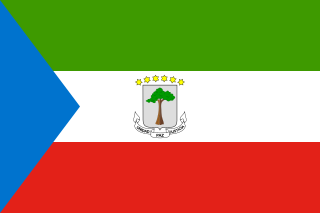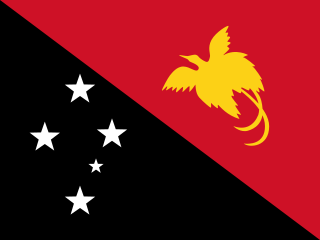
Equatorial Guinea, officially the Republic of Equatorial Guinea, is a country located on the west coast of Central Africa, with an area of 28,000 square kilometres (11,000 sq mi). Formerly the colony of Spanish Guinea, its post-independence name evokes its location near both the Equator and the Gulf of Guinea. Equatorial Guinea is the only sovereign African state in which Spanish is the official language. As of 2015, the country had an estimated population of 1,222,245.

Guinea, officially the Republic of Guinea, is a west-coastal country in West Africa. Formerly known as French Guinea, the modern country is sometimes referred to as Guinea-Conakry in order to distinguish it from other countries with "Guinea" in the name and the eponymous region, such as Guinea-Bissau and Equatorial Guinea. Guinea has a population of 12.4 million and an area of 245,860 square kilometres (94,927 sq mi).

Papua New Guinea, officially the Independent State of Papua New Guinea is a country in Oceania that occupies the eastern half of the island of New Guinea and its offshore islands in Melanesia, a region of the southwestern Pacific Ocean north of Australia. Its capital, located along its southeastern coast, is Port Moresby. The western half of New Guinea forms the Indonesian provinces of Papua and West Papua.
The Papua New Guinea national cricket team, nicknamed the Barramundis, is the team that represents the country of Papua New Guinea in international cricket. The team is organised by Cricket PNG, which has been an associate member of the International Cricket Council (ICC) since 1973. Papua New Guinea previously had One Day International (ODI) status, which it gained by finishing fourth in 2014 World Cup Qualifier. Papua New Guinea lost both their ODI and T20I status in March 2018 after losing a playoff match against Nepal during the 2018 Cricket World Cup Qualifier, a result that earned ODI and T20I status for their opponents. On 26 April 2019, at the final World Cricket League 2 fixture; PNG defeated Oman to finish at the fourth position and reclaim their ODI status.

The continent of Australia, sometimes known in technical contexts by the names Sahul, Australinea or Meganesia to distinguish it from the country of Australia, consists of the land masses which sit on Australia's continental plate. This includes mainland Australia, Tasmania, and the island of New Guinea. Situated in the geographical region of Oceania, it is the smallest of the seven traditional continents in the English conception.

Pseudonoorda is a genus of moths of the family Crambidae.
Pseudonoorda brunneiflava is a moth in the family Crambidae. It was described by Munroe in 1974. It is found in New Guinea.
Pseudonoorda distigmalis is a moth in the family Crambidae. It was described by George Hampson in 1913. It is found in the Democratic Republic of the Congo, Cameroon and Nigeria.
Pseudonoorda hemileuca is a moth in the Crambidae family. It was described by Turner in 1933. It is found in Australia, where it has been recorded from New South Wales and Queensland.
Pseudonoorda lampra is a moth in the family Crambidae. It was described by Tams in 1935. It is found on Samoa.
Pseudonoorda metalloma is a moth in the family Crambidae. It was described by Lower in 1903. It is found in Australia, where it has been recorded from Western Australia.
Pseudonoorda minor is a moth in the family Crambidae. It was described by Munroe in 1974. It is found in New Guinea.
Pseudonoorda nigropunctalis is a moth in the family Crambidae. It was described by George Hampson in 1899. It is found in Malaysia.
Pseudonoorda nitidalis is a moth in the family Crambidae. It was described by Pagenstecher in 1900. It is found on the Bismarck Archipelago.
Pseudonoorda noordimimalis is a moth in the family Crambidae. It was described by George Hampson in 1917. It is found in Ghana.
Pseudonoorda photina is a moth in the family Crambidae. It was described by Tams in 1935. It is found on Samoa.

Pseudonoorda rubricostalis is a moth in the family Crambidae. It was described by George Hampson in 1910. It is found in the Democratic Republic of the Congo, Namibia, Zambia and Zimbabwe.
Pseudonoorda edulis is a moth in the family Crambidae. It was described by Maes and Poligui in 2012. It is found in Cameroon, Gabon and Ivory Coast.
Pseudonoorda faroensis is a moth in the family Crambidae. It was described by Maes in 2012. It is found in Cameroon.
Pseudonoorda flammea is a moth in the family Crambidae. It was described by Maes in 2012. It is found in Cameroon and the Democratic Republic of Congo.





